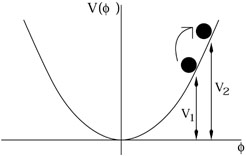


5.10. The Beginnings of Inflation
If inflation begins, we have seen that it achieves remarkable results. It can be shown quite generally that the start of inflation in a previously non-inflating region requires pre-existing homogeneity over a horizon volume [198]. It seems unlikely that classical, causal physics could cause this and we may interpret this as an indication that quantum physics may play a role in the process of inflation.
Although it can be shown [199, 200, 201, 202, 203] that inflation cannot be past eternal, one consequence of quantum mechanics is that inflation may be future eternal [204, 205, 206, 207, 208]. To see this, consider inflation driven by a scalar field rolling down a simple potential as in figure (5.11).
 |
Figure 5.11. |
Imagine that, in a given space-like patch, inflation is occurring with the scalar field at a potential energy V1. Although the classical motion of the scalar field is towards the minimum of the potential, there is a nonzero probability that quantum fluctuations will cause the inflaton to jump up to a higher value of the potential V2 > V1 over a sufficiently large part of the inflating patch. In the new region, the Friedmann equation tells us that the local Hubble parameter is now larger than in the inflating background
 |
(226) |
and requiring the region to be sufficiently large means that its linear size is at least H2-1, which may be considerably smaller than the size of the background inflationary horizon. Thus, inflation occurs in our new region with a larger Hubble parameter and, because of the exponential nature of inflation, the new patch very quickly contains a much larger volume of space than the old one.
There are, of course, parts of space in which the classical motion of the inflaton to its minimum completes, and those regions drop out of the inflationary expansion and are free to become regions such of our own. However, it is interesting to note that, as long as the probability for inflation to begin at all is not precisely zero, any region like ours observed at a later time comes from a previously inflating region with probability essentially unity. Nevertheless, in this picture, most regions of the universe inflate forever and therefore this process is known as eternal inflation.
If correct, eternal inflation provides us with an entirely new global view of the universe and erases many of our worries about the initial condition problems of inflation. However, some caution is in order when considering this model. Eternal inflation relies on the quantum backreaction of geometry to matter fluctuations over an extended spatial region. This is something we do not know how to treat fully at the present time. Perhaps string theory can help us with this.
Acknowledgements
We would each like the thank the TASI organizers (Howard Haber, K.T. Mahantappa, Juan Maldacena, and Ann Nelson) for inviting us to lecture and for creating such a vigorous and stimulating environment for students and lecturers alike. We would also like to thank the Kavli Institute for Theoretical Physics for hospitality while these proceedings were being completed.
The work of SMC is supported in part by U.S. Dept. of Energy contract DE-FG02-90ER-40560, National Science Foundation Grant PHY01-14422 (CfCP) and the David and Lucile Packard Foundation. The work of MT is supported in part by the National Science Foundation (NSF) under grant PHY-0094122. Mark Trodden is a Cottrell Scholar of Research Corporation.